Related Research Articles
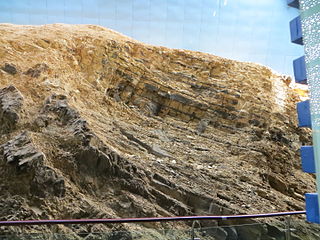
The Maotianshan Shales are a series of Early Cambrian deposits in the Chiungchussu Formation, famous for their Konservat Lagerstätten, deposits known for the exceptional preservation of fossilized organisms or traces. The Maotianshan Shales form one of some forty Cambrian fossil locations worldwide exhibiting exquisite preservation of rarely preserved, non-mineralized soft tissue, comparable to the fossils of the Burgess Shale. They take their name from Maotianshan Hill in Chengjiang County, Yunnan Province, China.

Dickinsonia is an extinct genus of basal animal that lived during the late Ediacaran period in what is now Australia, China, India, Russia and Ukraine. The individual Dickinsonia typically resembles a bilaterally symmetrical ribbed oval. Its affinities are presently unknown; its mode of growth is consistent with a stem-group bilaterian affinity, though some have suggested that it belongs to the fungi, or even an "extinct kingdom". The discovery of cholesterol molecules in fossils of Dickinsonia lends support to the idea that Dickinsonia was an animal.

Charnia is a genus of frond-like Ediacaran lifeforms with segmented, leaf-like ridges branching alternately to the right and left from a zig-zag medial suture. The genus Charnia was named after Charnwood Forest in Leicestershire, England, where the first fossilised specimen was found. Charnia is significant because it was the first Precambrian fossil to be recognized as such.
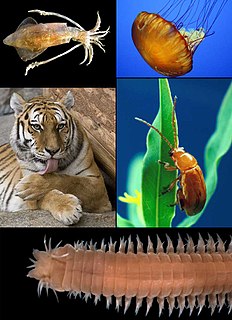
Eumetazoa, also known as Diploblasts, Epitheliozoa, or Histozoa, are a proposed basal animal clade as a sister group of the Porifera. The basal Eumetazoan clades are the Ctenophora and the ParaHoxozoa. Placozoa is now also seen as an Eumetazoan in the ParaHoxozoa.
The Cryogenian is a geologic period that lasted from 720 to 635 million years ago. It forms the second geologic period of the Neoproterozoic Era, preceded by the Tonian Period and followed by the Ediacaran.

Yorgia waggoneri is a discoid Ediacaran organism. It has a low, segmented body consisting of a short wide "head", no appendages, and a long body region, reaching a maximum length of 25 cm (9.8 in). It is classified within the extinct animal phylum Proarticulata.
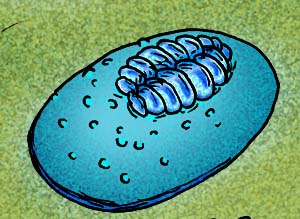
Cephalonega stepanovi is a fossil organism from Ediacaran deposits of the Arkhangelsk Region, Russia. It was described by Mikhail A. Fedonkin in 1976
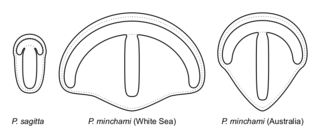
Parvancorina is a genus of shield-shaped bilaterally symmetrical fossil animal that lived in the late Ediacaran seafloor. It has some superficial similarities with the Cambrian trilobite-like arthropods.
Namapoikia rietoogensis is among the earliest known animals to produce a calcareous skeleton. Known from the Ediacaran period, before the Cambrian explosion of calcifying animals, the long-lived organism grew up to a metre in diameter and resembles a colonial sponge. It was an encruster, filling vertical fissures in the reefs in which it originally grew.

The Ediacaranbiota is a taxonomic period classification that consists of all life forms that were present on Earth during the Ediacaran Period. These were composed of enigmatic tubular and frond-shaped, mostly sessile, organisms. Trace fossils of these organisms have been found worldwide, and represent the earliest known complex multicellular organisms.
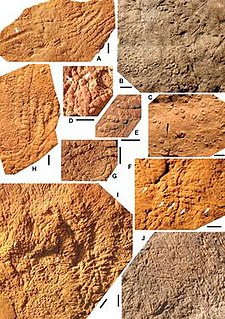
Funisia is a genus containing the single species F. dorothea, a fossil upright worm-like animal from the Ediacaran biota discovered in Australia. Funisia stood about 0.3 metres tall. Because individuals grew in dense collections of animals the same age, it is believed to have reproduced sexually. Although the evolution of sex took place before the origin of animals, and evidence of sexual reproduction is observed in red algae 1,200 million years ago, Funisia is one of the oldest known animals for which there is evidence of sexual reproduction. Its relationship to other animals is unknown, but it may belong within the Porifera (sponges) or Cnidaria, or it may have been a basal metazoan. The genus and species were described in a 2008 paper.
The Khatyspyt Formation is a Neoproterozoic formation exposed in the Olenëk Uplift of north central Siberia, which contains the only known instance of the Ediacara biota preserved in a limestone bed. The Khatyspyt Formation forms one of the major parts of the Khorbusuonka Group; underlying the Khatyspyt are dolomites of the Mastakh Formation and their overlying red beds; the Turkut Formation overlies the Khatyspyt. The Khatyspyt and part of the overlying Turkut comprise a major shallowing upward marine carbonate sequence. Khatyspytia is named after this formation.
The small shelly fauna, small shelly fossils (SSF), or early skeletal fossils (ESF) are mineralized fossils, many only a few millimetres long, with a nearly continuous record from the latest stages of the Ediacaran to the end of the Early Cambrian Period. They are very diverse, and there is no formal definition of "small shelly fauna" or "small shelly fossils". Almost all are from earlier rocks than more familiar fossils such as trilobites. Since most SSFs were preserved by being covered quickly with phosphate and this method of preservation is mainly limited to the late Ediacaran and early Cambrian periods, the animals that made them may actually have arisen earlier and persisted after this time span.
The Cambrian explosion or Cambrian radiation was an event approximately 541 million years ago in the Cambrian period when practically all major animal phyla started appearing in the fossil record. It lasted for about 13 – 25 million years and resulted in the divergence of most modern metazoan phyla. The event was accompanied by major diversifications in other groups of organisms as well.
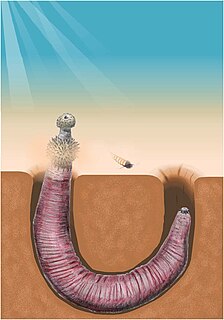
Archaeopriapulida is a group of priapulid-like worms known from Cambrian lagerstätte. The group is closely related to, and very similar to, the modern Priapulids. It is unclear whether it is mono- or polyphyletic. Despite a remarkable morphological similarity to their modern cousins, they fall outside of the priapulid crown group, which is not unambiguously represented in the fossil record until the Carboniferous. They are probably closely related or paraphyletic to the palaeoscolecids; the relationship between these basal worms is somewhat unresolved.

Eldonia is an extinct soft-bodied cambroernid animal of unknown affinity, best known from the Fossil Ridge outcrops of the Burgess Shale, particularly in the 'Great Eldonia layer' in the Walcott Quarry. In addition to the 550 collected by Walcott, 224 specimens of Eldonia are known from the Greater Phyllopod bed, where they comprise 0.43% of the community. Species also occur in the Chengjiang biota, and in Upper Ordovician strata of Morocco.

Stromatoveris psygmoglena is a genus of fossil organism from the Chengjiang deposits of Yunnan that was originally aligned with the fossil Charnia from the Ediacara biota. However, such an affinity is developmentally implausible and S. psygmoglena is now thought to be either a sessile basal ctenophore, or a sessile organism closely related to ctenophores. Nevertheless, a 2018 phylogenetic analysis by Jennifer Hoyal Cuthill and Jian Han indicated that Stromatoveris was a member of Animalia and closely related to ediacaran frond-like lifeforms.
Palaeoplatoda is a genus from the Ediacaran biota. It is a soft-bodied organism with a segmented body that resembles Dickinsonia, another Ediacaran organism.

The petalonams (Petalonamae) are an extinct group of archaic animals typical of the Ediacaran biota, also called frondomorphs, dating from approximately 579 million years ago to 541 Ma. They are benthic and motionless animals, that have the shape of leaves, fronds (frondomorphic), feathers or spindles and that at first were considered algae, octocorals or sea pens, but now it is believed that they did not leave current descendants and that they would have a probable relation with the Ediacaran animals called Vendozoans.
References
- ↑ Shu, D. G.; Conway Morris, S.; Han, J.; Li, Y.; Zhang, X. L.; Hua, H.; Zhang, Z. F.; Liu, J. N.; Guo, J. F.; Yao, Y.; Yasui, K. (May 2006). "Lower Cambrian Vendobionts from China and Early Diploblast Evolution". Science. 312 (5774): 731–734. Bibcode:2006Sci...312..731S. doi:10.1126/science.1124565. PMID 16675697. S2CID 1235914.
- ↑ Grazhdankin, Dima (2004). "Patterns of distribution in the Ediacaran biotas: facies versus biogeography and evolution". Paleobiology. 30 (2): 203–221. doi:10.1666/0094-8373(2004)030<0203:PODITE>2.0.CO;2. ISSN 0094-8373.